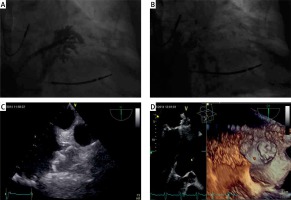Atrial fibrillation (AF) is a frequent occurrence in patients with hypertrophic cardiomyopathy (HCM). These patients require anticoagulation for the prevention of thromboembolic complications irrespectively of their CHA2DS2-VASc score [1]. The European Society of Cardiology guidelines recommend the use of vitamin K antagonists as first line therapy for this indication, with new oral anticoagulants as an alternative choice [1]. There are, however, no recommendations for left atrial appendage (LAA) closure in this population, despite confirmed efficacy for primary and secondary stroke prevention in various non-valvular AF scenarios, where standard anticoagulation cannot be safely used [2, 3].
An 88-year-old woman with HCM had undergone successful alcohol septal ablation (left ventricular outflow tract gradient decreased from 130 mm Hg to 17 mm Hg after the procedure and 7 mm Hg at the recent follow-up) and pacemaker implantation in the past and had for some years suffered from paroxysmal AF.
At first she was treated with warfarin, but due to problems with attaining stable therapeutic international normalized ratio (INR) (repeatedly low to very high values) she was switched to a new oral anticoagulant – also withdrawn due to repeatedly occurring ocular hemorrhage. Her HAS-BLED score was 3, indicating high risk of bleeding. In effect, as anticoagulation did not seem a viable choice and the patient was unwilling to try another drug, a decision was made to close the LAA. The left atrial diameter in the parasternal long axis view in transthoracic echo was 54 mm and LAA outlet dimensions on the transesophageal echo (TEE) were 2.3 × 2.3 × 2.5 cm, the landing zone 2.0–2.1 cm and the LAA depth was 3.0-3.3 cm; there were no signs of thrombus. A trace of left to right shunt through patent foramen ovale was noted. Under general anesthesia and with TEE monitoring a 30 mm Watchman device was implanted and the LAA successfully closed (Figures 1 A, B). The patient was started on ASA 75 mg QD and clopidogrel 75 mg QD. A TEE examination at 42 days revealed a correctly positioned Watchman device, no leak and no thrombi (Figures 1 C, D). Clopidogrel was stopped and a decision was made to continue ASA indefinitely [4]. The tolerance of current therapy is good with no complications. During 3.5-year follow-up there were no thromboembolic complications and the patient remains clinically stable. Computed tomography one year after the procedure revealed a correctly thrombosed Watchman device with no leak. In conclusion, it seems that LAA closure may be a viable alternative to anticoagulation in HCM patients with poor drug tolerance. Any further conclusions require a larger study in this group of patients with high risk of thromboembolism due to AF episodes.









